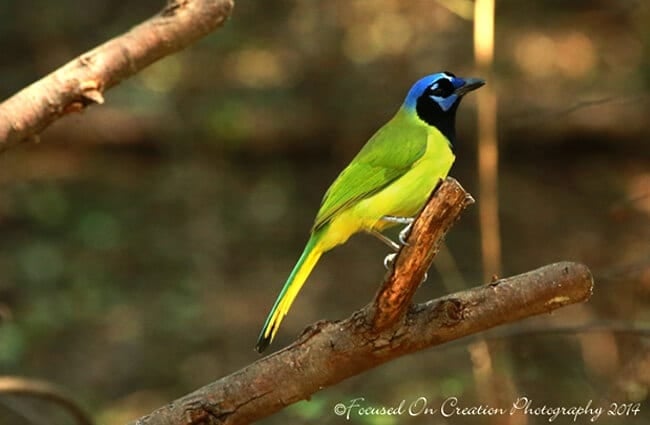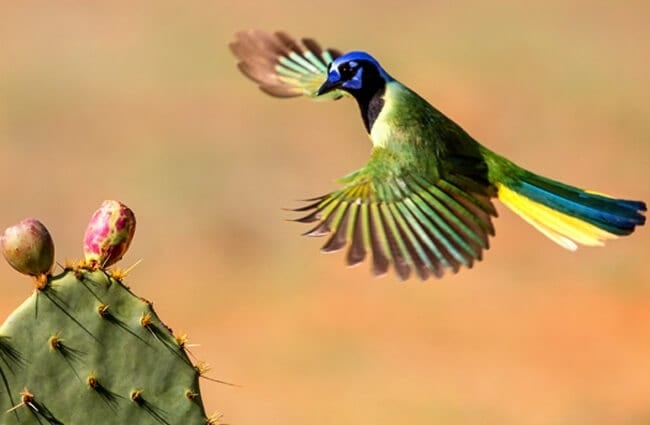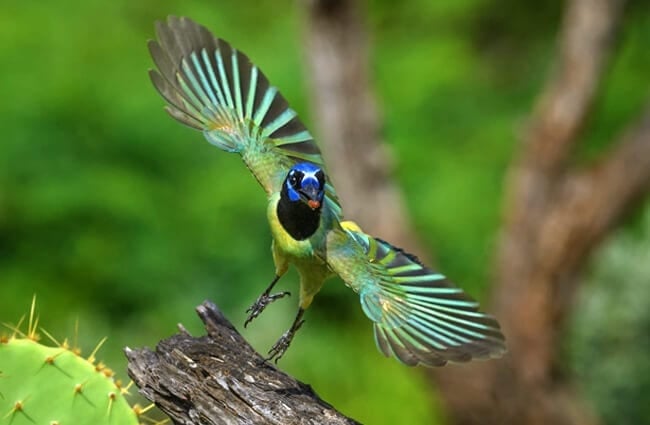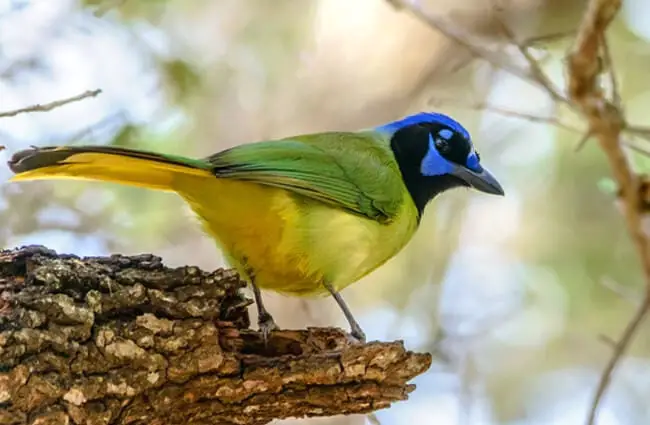The vibrant Green Jay, a striking member of the corvid family, is a captivating bird that inhabits the brushlands, woodlands, and thorny forests of the American Southwest and Mexico. More than just a beautiful sight, this intelligent and social bird plays a crucial role in its ecosystem. This comprehensive guide delves into the fascinating world of the Green Jay, exploring its habitat, behavior, diet, and much more.

Understanding the Green Jay
A Distinctive Appearance
The Green Jay, scientifically known as Cyanocorax passerinus, is easily recognizable by its striking plumage. The dominant color is a vibrant green, particularly noticeable on its back and wings. This contrasts with a gray breast, a dark blue cap, and a white throat patch. A distinctive black mask extends around the eyes, giving it an alert expression. Adults typically measure between 11 to 12 inches in length with a wingspan of about 13 to 16 inches. Young birds exhibit a duller coloration, gradually gaining their adult plumage as they mature.
Habitat and Distribution
Green Jays are primarily found in the southwestern United States, including Texas, Oklahoma, Arizona, and New Mexico, as well as throughout much of Mexico and parts of Central America. They prefer arid and semi-arid environments, thriving in thorny acacia woodlands, mesquite thickets, riparian areas, and suburban gardens. Their habitat selection is strongly tied to the availability of water sources and food, particularly fruits, berries, and insects. They exhibit a preference for areas with dense vegetation, providing cover from predators and nesting sites. They are considered non-migratory, generally remaining within their established territories year round.
Behavior and Social Life
Social Structure and Communication
Green Jays are highly social birds, often found in cooperative breeding groups consisting of a breeding pair and several helper birds, typically offspring from previous years. These helpers assist in raising the current brood, defending the territory, and foraging for food. This cooperative behavior increases the breeding success rate and enhances the survival of the group. They communicate using a variety of vocalizations, including harsh scolding calls, melodic whistles, and complex chattering sounds. These vocalizations serve various purposes, such as maintaining contact within the group, warning of danger, and coordinating foraging efforts.

Diet and Foraging
Green Jays are omnivorous, with a varied diet that changes seasonally. Fruits and berries constitute a significant portion of their diet, especially during the warmer months. They also consume insects, caterpillars, acorns, seeds, and occasionally small lizards or rodents. They are opportunistic feeders, readily exploiting any available food source. Green Jays are known for caching food—hiding acorns and other items in crevices and under leaf litter—to be retrieved later, particularly during times of scarcity. This caching behavior is essential for their survival during the winter months.
Reproduction and Life Cycle
Mating and Nesting
Green Jays typically mate for life, forming strong pair bonds. Breeding season generally occurs from late March to June. They build a cup-shaped nest constructed from twigs, grasses, and mud, usually placed in a dense shrub or small tree, typically between 6 to 20 feet above the ground. The female lays a clutch of 3 to 5 eggs, which are pale green or bluish with brown markings. Both parents participate in incubating the eggs for about 17 to 19 days.
Raising the Young
Once hatched, the young birds are altricial—meaning they are helpless and require extensive care from their parents. Both parents feed the nestlings a diet of insects and fruits. Helper birds also contribute to feeding and protecting the young. The fledglings leave the nest after about 21 to 23 days but remain dependent on their parents for several weeks. Young Green Jays typically reach sexual maturity at around one year of age.

Ecological Role and Interactions
Seed Dispersal and Pollination
Green Jays play a vital role in seed dispersal, consuming fruits and berries and then depositing the seeds in different locations through their droppings. This process aids in the regeneration of plant communities. They are also known to visit flowering plants, inadvertently contributing to pollination. Their foraging behavior helps maintain the health and diversity of their ecosystem.
Interactions with Other Animals
Green Jays interact with a variety of other animals. They are known to mob predators, such as hawks and snakes, driving them away from their territory. They often forage alongside other bird species, such as woodpeckers and warblers. They are sometimes preyed upon by larger raptors, snakes, and mammals.
Green Jays and Humans
Observation and Conservation
Observing Green Jays in their natural habitat can be a rewarding experience. They are relatively bold and approachable, often frequenting suburban gardens and parks. Their populations are currently stable, but habitat loss and fragmentation pose potential threats. Supporting conservation efforts aimed at protecting their natural habitats is crucial for ensuring their long-term survival.

Interesting Facts
- Green Jays are known for their intelligence and problem-solving abilities.
- They can mimic the calls of other birds and animals.
- They often bathe in puddles or shallow water.
- They are capable of learning and adapting to new situations.
- They have a lifespan of up to 15 years in the wild.
For the Avid Birder and Zoologist
Evolutionary History
The Green Jay belongs to the Corvidae family, a group known for their intelligence, social complexity, and adaptability. Corvids are believed to have originated in Asia millions of years ago and subsequently dispersed to other parts of the world. The Green Jay’s evolutionary lineage can be traced back to the ancestors of other North American jays and magpies. Genetic studies have revealed that the Green Jay is closely related to the Brown Jay, another species found in the southwestern United States and Mexico.
Captive Care
For zookeepers and aviculturists, providing appropriate care for Green Jays requires a deep understanding of their complex needs. A spacious enclosure mimicking their natural habitat—including shrubs, trees, and thorny vegetation—is essential. Their diet should consist of a variety of fruits, insects, seeds, and a formulated bird food. Providing enrichment activities, such as puzzle feeders and foraging opportunities, is crucial for stimulating their intelligence and preventing boredom. Regular veterinary checkups and monitoring for common avian diseases are also essential.

Encountering a Green Jay in the Wild
If you encounter a Green Jay in the wild, observe it from a respectful distance. Avoid approaching it or attempting to feed it. Do not disturb its nest or habitat. Enjoy the opportunity to witness this intelligent and beautiful bird in its natural environment. A pair of binoculars and a field guide can greatly enhance your birdwatching experience.

The Green Jay, with its vibrant plumage, complex behavior, and ecological importance, is a truly remarkable species. By learning more about this fascinating bird, we can appreciate its role in our ecosystem and contribute to its conservation for generations to come.

![Red Angus Closeup of a beautiful Red Angus cowPhoto by: U.S. Department of Agriculture [pubic domain]https://creativecommons.org/licenses/by/2.0/](https://animals.net/wp-content/uploads/2020/03/Red-Angus-4-238x178.jpg)




![Red Angus Closeup of a beautiful Red Angus cowPhoto by: U.S. Department of Agriculture [pubic domain]https://creativecommons.org/licenses/by/2.0/](https://animals.net/wp-content/uploads/2020/03/Red-Angus-4-100x75.jpg)

